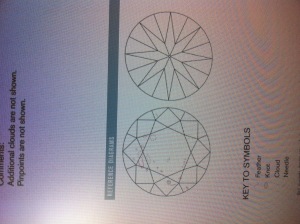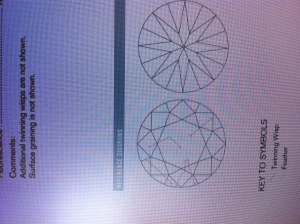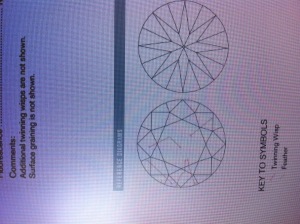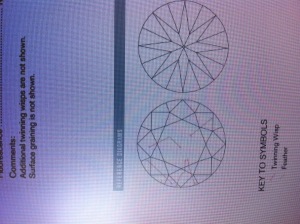You are using an out of date browser. It may not display this or other websites correctly.
You should upgrade or use an alternative browser.
You should upgrade or use an alternative browser.
Clarity 'key symbols' which can be seen most often?
- Thread starter London
- Start date
- Joined
- Sep 19, 2009
- Messages
- 204
1.Crystal and Feather most obvious.
2.Cloud- stay away from clarities that have a comment which says "Clarity grade is based on cloud throughout stone, or based on clouds that are not shown.
3.Knot- this is usually a crystal that touches the surface.
4.Needle- usually not an SI type of inclusion.
With GIA reports when looking at the key to symbols, the first one or two clarity characteristics listed are supposed to be the grade setter.
If two inclusions carry equal weight and one is a feather, GIA will put the totally internal inclusion first which will be the crystal or the cloud, because feathers reach the surface and cloud potentially be removed with re-cutting depending on the weight of the stone.
2.Cloud- stay away from clarities that have a comment which says "Clarity grade is based on cloud throughout stone, or based on clouds that are not shown.
3.Knot- this is usually a crystal that touches the surface.
4.Needle- usually not an SI type of inclusion.
With GIA reports when looking at the key to symbols, the first one or two clarity characteristics listed are supposed to be the grade setter.
If two inclusions carry equal weight and one is a feather, GIA will put the totally internal inclusion first which will be the crystal or the cloud, because feathers reach the surface and cloud potentially be removed with re-cutting depending on the weight of the stone.
30yearsofdiamonds|1398354123|3659159 said:1.Crystal and Feather most obvious.
2.Cloud- stay away from clarities that have a comment which says "Clarity grade is based on cloud throughout stone, or based on clouds that are not shown.
3.Knot- this is usually a crystal that touches the surface.
4.Needle- usually not an SI type of inclusion.
With GIA reports when looking at the key to symbols, the first one or two clarity characteristics listed are supposed to be the grade setter.
If two inclusions carry equal weight and one is a feather, GIA will put the totally internal inclusion first which will be the crystal or the cloud, because feathers reach the surface and cloud potentially be removed with re-cutting depending on the weight of the stone.
Thank you so much!
So does this look like it probably won't be eye clean?

- Joined
- Sep 19, 2009
- Messages
- 204
- Joined
- Jul 27, 2009
- Messages
- 4,097
Dan,30yearsofdiamonds|1398358462|3659218 said:As a trade member, I'm not allowed to comment on stones up for sale, sorry, but I am sure there will be additional advice coming to you.
I believe it is within the rules for you to comment in that no vendor info is revealed or implied. I may be wrong about that, but here is my comment anyway:
Alot depends on how big the diamond is. The larger the stone, the larger the allowable size of inclusion for a given grade. It's somewhat of a relative thing. That is, the same crystal that would result in a grade of Si1 in a half carat, would make VS2 in a two carat (hypothetically). Hence, in order for the two carat to be downgraded to Si1 the crystal would have to be larger. So what is eye-clean in smaller Si1 becomes visible at larger diamond size.
30yearsofdiamonds|1398354123|3659159 said:With GIA reports when looking at the key to symbols, the first one or two clarity characteristics listed are supposed to be the grade setter.
If two inclusions carry equal weight and one is a feather, GIA will put the totally internal inclusion first which will be the crystal or the cloud, because feathers reach the surface and cloud potentially be removed with re-cutting depending on the weight of the stone.
Interesting that 'If two inclusions carry equal weight and one is a feather, GIA will put the totally internal inclusion first which will be the crystal or the cloud,'
but I have never seen it written before that 'because feathers reach the surface and could potentially be removed with re-cutting'.
All feathers don't reach the surface do they? They are normally marked red and not green on diamond reports are they not?
Texas Leaguer|1398359538|3659229 said:Dan,30yearsofdiamonds|1398358462|3659218 said:As a trade member, I'm not allowed to comment on stones up for sale, sorry, but I am sure there will be additional advice coming to you.
I believe it is within the rules for you to comment in that no vendor info is revealed or implied. I may be wrong about that, but here is my comment anyway:
Alot depends on how big the diamond is. The larger the stone, the larger the allowable size of inclusion for a given grade. It's somewhat of a relative thing. That is, the same crystal that would result in a grade of Si1 in a half carat, would make VS2 in a two carat (hypothetically). Hence, in order for the two carat to be downgraded to Si1 the crystal would have to be larger. So what is eye-clean in smaller Si1 becomes visible at larger diamond size.
This diamond 2.15 carat and graded SI1 by GIA. So if I am understanding you correctly since this is a larger stone the inclusions are more likely to be seen with the naked eye?
- Joined
- Sep 19, 2009
- Messages
- 204
The Key to symbol rule is a GIA in house Lab rule that is supposed to be followed. This rule was designed more so for larger stones that had feathers and internal crystals,etc, so that the manufacturer wouldn't think that the clarity could be improved with re-cutting.
The 2nd question about feathers reaching the surface. A GIA grader when plotting the location of an inclusion designated as a feather is plotted where it "Touches" the diamonds surface. This technically means that all feathers touch the surface, but what needs to be understood is that feathers can look totally different then what the plot shows. As an example, a feather that can be seen face up extending all the way to the table center from the pavilion(bottom) of the stone would be plotted where it touches the bottom as a line only as big as the feather contacts the surface. Hope this makes sense to the typical PS reader.
3rd question- The stone is a pretty good size, and an SI1 feather on the star facet, or the knot could possibly be visible when held in the right position with back lighting. Its a pretty busy stone for an SI1 with an additional comment on other clouds not plotted.
The 2nd question about feathers reaching the surface. A GIA grader when plotting the location of an inclusion designated as a feather is plotted where it "Touches" the diamonds surface. This technically means that all feathers touch the surface, but what needs to be understood is that feathers can look totally different then what the plot shows. As an example, a feather that can be seen face up extending all the way to the table center from the pavilion(bottom) of the stone would be plotted where it touches the bottom as a line only as big as the feather contacts the surface. Hope this makes sense to the typical PS reader.
3rd question- The stone is a pretty good size, and an SI1 feather on the star facet, or the knot could possibly be visible when held in the right position with back lighting. Its a pretty busy stone for an SI1 with an additional comment on other clouds not plotted.
- Joined
- Jul 27, 2009
- Messages
- 4,097
That is correct. You should have a detailed conversation with the vendor about how eye-clean the stone is if buying remotely. Communicate all aspects that are important to you and make sure the diamond conforms. For instance, if setting the stone in a four prong solitaire setting, you might be interested in whether it is eye-clean from side view. The primary default definition for eye-clean is viewing in face-up mode in overhead light. A stone could conform to this definition but have something visible from the side and/or with transmitted light.London|1398361260|3659249 said:This diamond 2.15 carat and graded SI1 by GIA. So if I am understanding you correctly since this is a larger stone the inclusions are more likely to be seen with the naked eye?
Make sure you have return privileges if it's not what you expected when you see it yourself.
- Joined
- Aug 4, 2008
- Messages
- 15,734
dittoTexas Leaguer|1398363124|3659262 said:That is correct. You should have a detailed conversation with the vendor about how eye-clean the stone is if buying remotely. Communicate all aspects that are important to you and make sure the diamond conforms. For instance, if setting the stone in a four prong solitaire setting, you might be interested in whether it is eye-clean from side view. The primary default definition for eye-clean is viewing in face-up mode in overhead light. A stone could conform to this definition but have something visible from the side and/or with transmitted light.London|1398361260|3659249 said:This diamond 2.15 carat and graded SI1 by GIA. So if I am understanding you correctly since this is a larger stone the inclusions are more likely to be seen with the naked eye?
Make sure you have return privileges if it's not what you expected when you see it yourself.
I have seen si stones with busy plots that were totally eye clean from all angles and diamonds with plots with 3 inclusions that all 3 were eye visible face up and the reverse.
London|1398620570|3661289 said:
I have been studying up on this a little more and what I've gathered is that twinning can affect brilliance negatively. Is this correct? Also can you tell if these are feathers that need to be worried about from the diagram? Are they close to the edge? Do they compromise integrity?
- Joined
- Sep 19, 2009
- Messages
- 204
Twinning wisps do not compromise durability, they are totally internal and are nothing like a feather. Unfortunately the symbol used by GIA to designate their presence makes the stone look a lot worse in many cases. I happen to like and look for stones that are SI1-SI2 with twinning wisps because I find them to be less noticeable then similar graded stones based on crystals, feathers or clouds.
London|1398620570|3661289 said:
Just for reference, here is a pic of the stone. Obviously it is a pass. But wanted anyone interested to see what twinning and feathers in a SI1, not always, but can look like.

Share:
The Ultimate Guide to Men’s Wedding Bands: Metals, Fit & Finish
The Ultimate Guide to Men’s Wedding Bands: Metals, Fit & Finish - 06/27
Chipped Diamonds: Causes, Risks, and What You Should Do About It
Chipped Diamonds: Causes, Risks, and What You Should Do About It - 06/27










300x240.png)